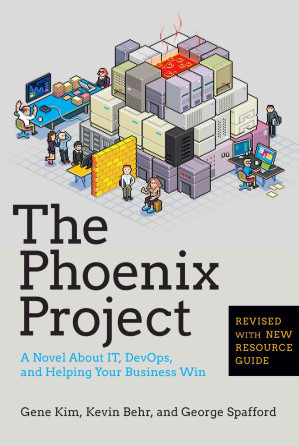Insights from The Phoenix Project
"The Phoenix Project: A Novel About IT, DevOps, and Helping Your Business Win" by Gene Kim, Kevin Behr, and George Spafford is a revolutionary book that uses a narrative style to illustrate the principles of DevOps and how they can transform IT operations to drive business success. Through the story of Parts Unlimited, the authors demonstrate the challenges and triumphs of implementing DevOps practices in a real-world setting.

Summary
The book begins with Parts Unlimited, a company facing a series of crises that threaten its survival. The protagonist, Bill Palmer, is unexpectedly promoted to VP of IT Operations and tasked with saving the Phoenix Project, a critical initiative for the company's turnaround.
Chapter 1: Introduction to the Crisis
Bill Palmer is introduced to the severity of Parts Unlimited's situation. The company is struggling with frequent outages, delayed projects, and a failing stock price. The Phoenix Project, intended to integrate retail and e-commerce channels, is years behind schedule and critical for the company's recovery.
Chapter 2: New Responsibilities
Bill learns about his new role and the enormous pressure he faces. He is tasked with stabilising IT operations and ensuring the Phoenix Project is completed on time. This chapter sets the stage for the immense challenges ahead.
Chapter 3: The First Battle
Bill starts tackling immediate IT issues, including a major payroll outage. He navigates organisational politics, firefighting technical problems, and begins to realise the depth of dysfunction within the IT department.
Chapter 4: Introducing DevOps Principles
The narrative introduces Erik Reid, a board member who becomes Bill's mentor. Erik introduces Bill to the principles of DevOps and Lean manufacturing, emphasising the importance of improving work processes, reducing batch sizes, and increasing flow.
Chapter 5: The Three Ways
Erik explains the Three Ways, which form the foundation of DevOps:
- The First Way focuses on improving the flow of work from Development to Operations to customers.
- The Second Way emphasises the creation of feedback loops that enable continuous improvement.
- The Third Way fosters a culture of continual experimentation and learning.
Chapter 6: Identifying Constraints
Bill and his team identify the key constraints in their IT processes that are causing delays and failures. They realise that improving these bottlenecks is essential to increasing overall efficiency.
Chapter 7: Making Work Visible
The team begins making all work visible using Kanban boards. This transparency helps identify where work is piling up and where the bottlenecks are, allowing for better prioritisation and resource allocation.
Chapter 8: Stabilising Operations
Bill focuses on stabilising daily operations to prevent constant firefighting. This includes implementing standardised processes, improving monitoring, and ensuring that teams have clear roles and responsibilities.
Chapter 9: Continuous Improvement
The narrative highlights the importance of continuous improvement. Bill's team starts implementing small, incremental changes to improve flow and reduce waste, aligning their efforts with the principles of Lean and Agile.
Chapter 10: Transforming Culture
A significant theme in the book is the cultural transformation required for DevOps. Bill works on breaking down silos, fostering collaboration, and creating a culture of trust and mutual respect.
Chapter 11: Achieving Success
Through persistent effort, Bill and his team start seeing improvements in their work processes and outcomes. The Phoenix Project begins to show signs of progress, and Parts Unlimited starts moving towards recovery.
Chapter 12: The Final Push
In the final chapters, the team faces their toughest challenges yet but manages to pull through by applying the DevOps principles they've learned. The Phoenix Project is successfully launched, demonstrating the transformative power of DevOps.
Key Takeaways
- Flow and Feedback: Improving the flow of work and creating feedback loops are crucial for continuous improvement.
- Visibility: Making work visible helps identify bottlenecks and prioritise tasks effectively.
- Collaboration: Breaking down silos and fostering a collaborative culture is essential for DevOps success.
- Continuous Improvement: Embracing a culture of continuous experimentation and learning drives long-term success.
- Leadership: Strong leadership is critical to driving change and overcoming resistance.
Personal Reflections
Reading "The Phoenix Project" has provided me with a deep understanding of how DevOps principles can transform IT operations. The narrative approach makes the concepts relatable and easier to grasp, highlighting the real-world challenges and benefits of adopting DevOps. The emphasis on culture, visibility, and continuous improvement resonates with my experiences in the tech industry.
Conclusion
"The Phoenix Project: A Novel About IT, DevOps, and Helping Your Business Win" by Gene Kim, Kevin Behr, and George Spafford is a must-read for anyone involved in IT operations or software development. It offers a compelling narrative that illustrates the power of DevOps to drive business success. By following the principles outlined in this book, organisations can achieve greater efficiency, innovation, and resilience in their IT operations.